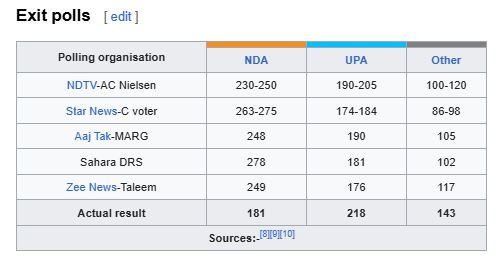Beyond Popular Belief: Will Modi Secure a Third Term? Lessons from 2004
"Déjà Vu or Déjà Who? Why Modi's Third Term Might Be a Hattrick or a Hiccup"
Introduction
As India nears the 2024 elections results, history seems to echo the 2004 political landscape. The parallels between then and now offer a compelling view of current dynamics, with political strategies and public sentiments playing out in a strikingly similar fashion. The stage is set for another pivotal moment.
From "India Shining" to Unequal Growth: 2004's Rural Disconnect and 2024's Ignored Issues
In 2004, the NDA's "India Shining" campaign under Atal Bihari Vajpayee highlighted economic growth and infrastructure, but it failed to address the immediate concerns of rural voters suffering from agrarian distress and unemployment. This disconnect allowed the Congress party, led by Sonia Gandhi, to capitalize on grassroots issues and connect with marginalized voters, resulting in an unexpected victory.
In 2024, the BJP, led by Narendra Modi, has shifted its focus towards national security, polarizing issues, and personal branding. I'm not sure if Modi's speeches frequently mentioned these topics in the last 15 days, but I have included the link to the diagram below for reference.
https://twitter.com/INCIndia/status/1796806366893310128
However, these speeches largely ignore pressing issues like inflation and employment, which are critical to many common voters.
In the current elections, this issue matters significantly because India is one of the most unequal countries in the world. The top 10% of the Indian population holds 77% of the total national wealth. In 2017, 73% of the wealth generated went to the richest 1%, while 670 million Indians, who make up the poorest half of the population, saw only a 1% increase in their wealth. This stark disparity means that a large portion of the population feels left behind and frustrated by the country's growth, potentially influencing the outcome of the elections.
"जहां अमीरी की चमक में गरीबों की आवाज़ खो जाती है, वहां चुनावों में बदलाव की बयार आती है।"
History Repeating? Exit Polls Favor BJP Again, But Will 2024 Echo 2004's Upset?
What is Exit Polls: Surveys conducted immediately after voters leave the polling stations to predict the outcome of an election.
Exit Polls: Misleading Predictions?
In 2004, exit polls showed BJP retaining power, but the actual results were a surprising defeat.
2024 Exit Polls: Once again, predictions favor BJP, but will the results align this time?
Only time will tell if the exit polls are accurate or if history will repeat itself.
"इतिहास गवाह है, कि जो दिखता है वो हमेशा सच नहीं होता। देखते हैं, इस बार सच्चाई क्या है।"
The Contrarian Perspective: When Majority Predictions Fail
Theory aligns with the "wisdom of crowds" and contrarian thinking, suggesting that when the majority expects a specific outcome, the opposite might occur. This implies that consensus often means all information is already considered, leaving no new insights to shift opinions or behaviors.
Here are a few examples from history where widespread expectations did not come true:
Brexit Referendum (2016): Many polls and pundits predicted that the United Kingdom would vote to remain in the European Union. However, the majority voted to leave, surprising many observers and markets.
U.S. Presidential Election (2016): Most polls and analysts predicted that Hillary Clinton would win the presidency. However, Donald Trump won the election, defying the expectations of the majority.
Dot-com Bubble (late 1990s to early 2000s): During the late 1990s, there was widespread optimism and investment in internet-based companies. Many believed that these companies would continue to grow indefinitely. However, the bubble burst in 2000, leading to significant financial losses for investors.
The Great Recession (2007-2008): Leading up to the financial crisis, there was a general belief that the housing market in the United States was stable and that real estate prices would continue to rise. The subsequent collapse of the housing market and the broader financial system took many by surprise.
French Revolution (1789): Leading up to the French Revolution, the majority of the population, including many in the aristocracy, did not foresee the extent of the upheaval and the eventual overthrow of the monarchy.
Throughout history, there have been numerous instances where the majority consensus has been proven wrong, as illustrated by the examples mentioned earlier. While there are fewer instances where majority predictions have aligned with outcomes, the current situation suggests a high probability that the prevailing consensus may not materialize.
"जिधर भीड़ की सोच जाती है, अकसर वहां हकीकत रास्ता बदल जाती है।"
Conclusion
As India approaches the 2024 elections, the parallels with the 2004 political landscape are striking. The BJP's focus on national security and polarizing issues, while neglecting critical concerns like inflation and employment, mirrors the NDA's "India Shining" campaign that overlooked rural distress. Despite exit polls favoring the BJP, history has shown that such predictions can be misleading. The significant wealth disparity in India further fuels voter frustration, potentially setting the stage for an unexpected outcome. History and contrarian thinking suggest that the prevailing consensus might not materialize, leaving the final election results in suspense.
"For a video summary that explains what I've discussed, please watch the following:
"
"History doesn't repeat itself, but it often rhymes." – Mark Twain
"Last but not least"
I leave you, dear reader, with one picture and no comment.
Disclosure:
This is my personal analysis, and actual results may vary. I have the right to express my views and also the right to be wrong. The information provided here is based on my own research and opinions. It should not be taken as definitive or legally binding. Readers are encouraged to form their own conclusions and seek additional sources of information where necessary.






